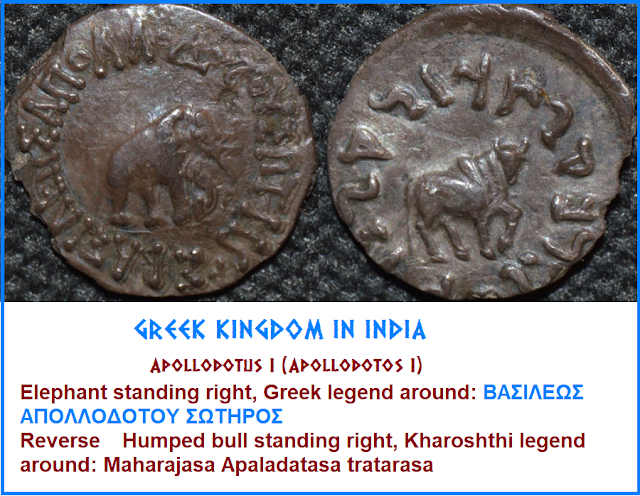It is a well-known fact that Greek Art and culture greatly affected Buddhism. It was the Greeks who first made a human Statue of the Buddha; a trend which later found its way into China. This trend of Buddhism was adopted for Hindu Gods as well. Indians did not have a concept of Temples in ancient times. The concept of making a human statue of a God, putting it in a free-standing temple and worshipping it originated from Greece. Hence the birth of the art movement of Greco- Buddhism.
Some of the earlier coins of king Apollodotus directly associate the elephant with Buddhist symbolism, such as the stupa hill (arched-hill symbol) surmounted by a crescent or a star (the Chaitya symbol); a feature also seen on the coins of the Mauryan Empire, many local coins of Taxila or those of the later Kuninda kingdom.
Also the zebu bull on the reverse is often shown with a nandipada taurine mark on its hump on the less-worn coins,something which strenghtens the role of the animal as a religious or geographic symbol, rather than a mere decorative image. The nandipada and the zebu bull are generally associated with Nandi, Shiva's humped bull in Hinduism. The same association was made later on coins of Zeionises or Vima Kadphises. The elephant, pendant to the bull, and shown with a girdle on the obverse, also must have a symbolic role, possibly Buddhist, as it was associated with the stupa hill in the earliest coins of Apollodotus.
Apollodotus experimented with different coin standards for his silver, until he concluded on a standard lighter than the Attic which would prevail for centuries. Later rulers,however, usually struck round coins instead of the square (typically Indian) shape of most of Apollodotus' silver. He issued a number of bronzes with the image of Apollo and a tripod, which were also very popular for centuries.
Apollodotus also issued a small series of monolingual Attic tetradrachms, intended for export into Bactria. For these, Apollodotus I clearly used Bactrian celators to strike an exquisite realistic portrait of the king as an aged man,wearing the Macedonian hat called kausia, with a reverse of sitting Goddess Athena holding Nike; a common Hellenistic motif introduced by the Diadoch Lysimachus. On these coins, he did not use an epithet for himself.
SOURCE: Wikipedia

















No comments:
Post a Comment